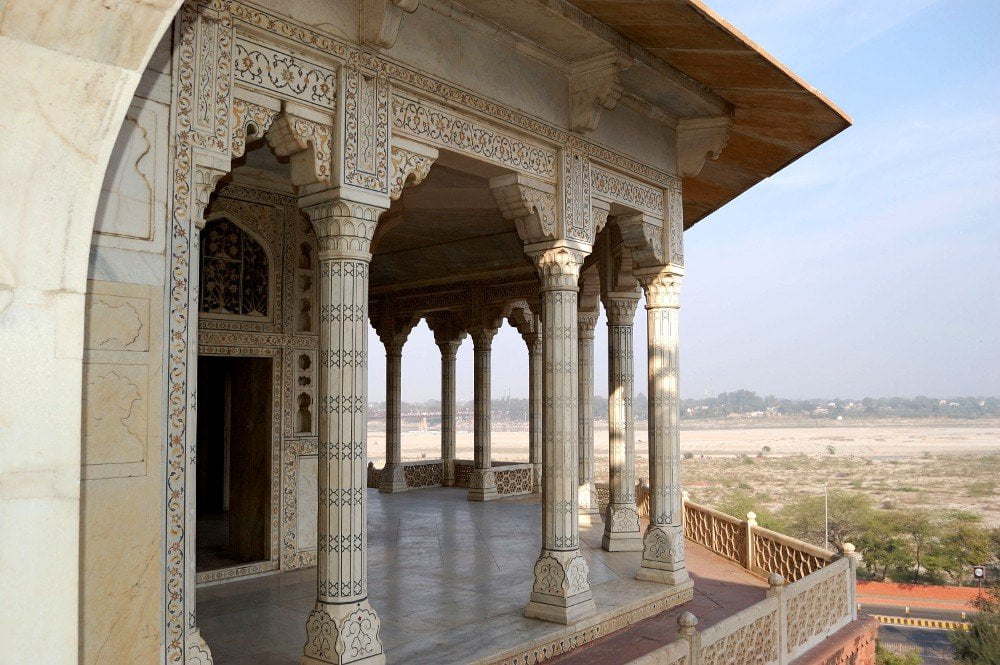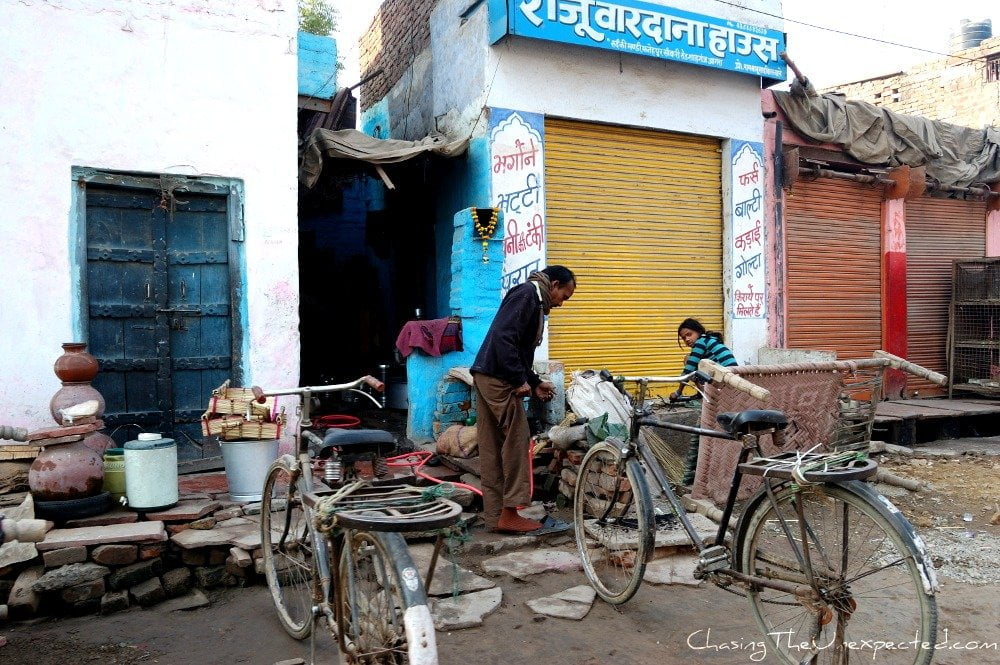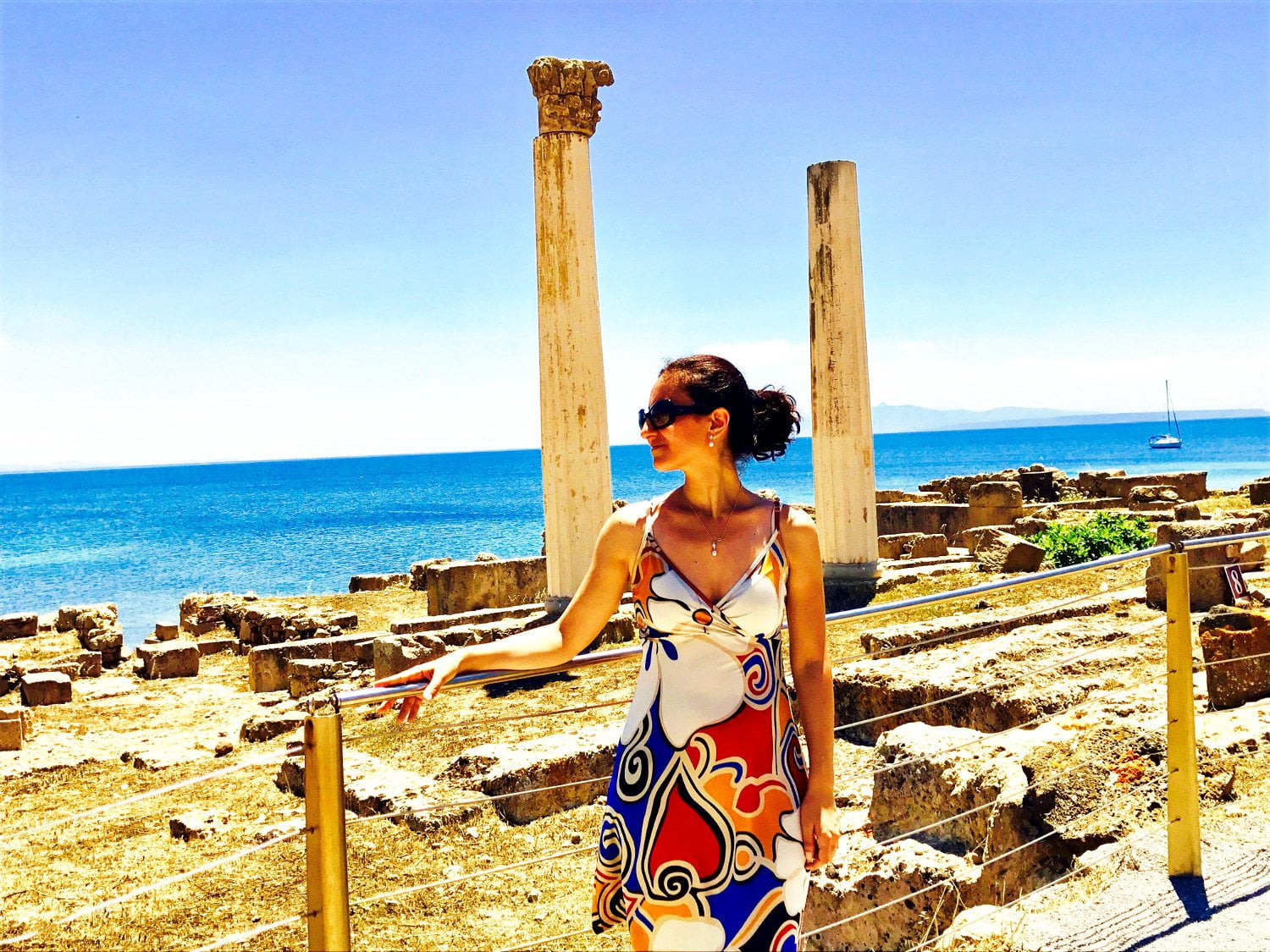The first day of my trip to India was spent in Agra, and the very first monument I’ve visited in the muslim-populated city was the huge Fort, the country’s most important fortress.
Most Mughal kings have lived there, and from here they also used to rule the country. This fort was started during the era of emperor Akbar the Great and is an impressive collaboration of palaces added by the following generations of kings, such as Jahangir, Shah Jahan and Aurangzeb, covering taste, mood, personality of every emperor who commissioned each piece.
The building is massive, very likely it was built in place of the old Badalgarh Fort, stronghold of Rajput rulers. Surrounded by a double wall, of which the outer one is 40 ft high and the inner one 70 ft, the fort was started in 1565 and completed in eight years, matching the different tastes of each of the Mughal kings that contributed in its creation.

I loved ambling along the alleys and the many palaces inside the Fort, while my guide Danish slowly unfolded the tales and legends behind every wall of the fort.
One of the greatest buildings is the red-sand-stone Jahangir’s Palace, built by Akbar the Great. History here is a little confused, the palace is believed to have been built by the king for his son, then later emperor Jahangir built another palace after demolishing one of the areas that Akbar had devoted to his Hindu wife Jodha Bai.
Stories of rivalry, love, passion, diversity are all entangled and brought to our times through the many styles present in this fort.
Wandering from one palace to the other, I passed by the gardens inside the fort. When I entered Anguri Bagh, or the Grape Garden, I was completely alone, not even my guide had already reached the spot as he was buying my ticket. Only one of the gardeners was having rest sitting in a corner of his green creation, certainly enjoying one of the rare moments of peace.
I shared that feeling of tranquility and loved contemplating the perfectly trimmed greenery. Unfortunately that was just that, a fleeting moment before a horde of yelling tourists came and broke the spell. No move, nor reaction came from the gardener, very likely used to such sudden change of atmosphere.

As I kept crossing the different palaces, listening to the pearls of knowledge Danish was giving me, I felt I could actually see the emperors, their wives, busy (or not-so-busy) in their daily routine, and the myriads of workers sweating under the pitiless Indian sun while building or readjusting the different parts of the mansion according to the rulers’ ever-changing demands.
The last block I visited in the Fort was Samman Burj (or Musamman Burj) where Mughal emperor Shah Jahan was confined by his son, just opposite the Taj Mahal, magnificent building he himself had commissioned in honor of his beloved wife, Mumtaz Mahal, who died after giving birth to their fourteenth child.

The death of his wife, brought to his mind every single day by the view of the Taj, literally drove him crazy. He slowly dragged himself to death, after torturing his last years with the view that reminded him of the most tragic moment of his life. That was my first encounter with the Taj Mahal, a masterpiece built out of grief and love.
Useful tips when visiting the Agra Fort

What is Agra Fort famous for
The fort in Agra was built by Mughal Emperor Akbar in the 16th century. It is a UNESCO World Heritage Site in the city of Agra in India. It was the main residence of the emperors of the Mughal Dynasty till 1638, when the capital was shifted from Agra to Delhi. It is about 2.5 km northwest of its more famous sister monument, the Taj Mahal.
The fort can be accurately described as a walled city. It has consisted of a number of buildings surrounded by Defensive Walls with numerous gates and towers. Initially it started off as a brick Fort known as Badalgarh, built by Sikandar Lodhi in the 16th century.
After Akbar it was extensively modified and improved by his successors Jahangir and Shah Jahan and achieved its present grandeur during their reigns. Shah Jahan particularly added some very beautiful palaces and other buildings inside, though not on the same scale or in the same style as at his new capital, Shahjahanabad (Old Delhi).
Even today one can see outstanding architectural marvels inside like Jehangir’s Quadrangle, Sheesh Mahal (‘Palace of Mirrors’), Hammam (Royal Baths) etc., which testify to their artistry.
What is the difference between Agra Fort and Red Fort?
Agra Fort and Delhi’s Red Fort are both imposing examples of Mughal architecture. However, there are some notable differences between the two. For one, Agra Fort is much smaller than Red Fort, measuring 2.5 times smaller in terms of total area. This is reflected in the layout of the two forts, as Agra Fort does not have the same expansive gardens and lawns as Red Fort.
Additionally, the architecture of the two forts is similar but not identical. Agra Fort is constructed primarily of red sandstone, while parts of the Red Fort like Moti Masjid is built from a white marble.
Finally, while both forts were once home to the Mughal rulers, Agra Fort fell into disuse after the capital was moved to Delhi in 1638, while Red Fort continued to be used as a residence by the Mughal emperors until 1857.
Today, both forts are popular tourist destinations, offering visitors a glimpse into the opulent world of the Mughal aristocracy.
The best time of the year to visit the Agra Fort
The best time of year to visit the Agra Fort would be in winter from December to March. Here is what you need to keep in mind when deciding when to visit Agra Fort: In most part of India, Spring is shorter than 1 month and the winter is fresh (not cold).
The weather in Agra is extremely hot during the summer months (April-July), with temperatures often reaching over 40 degrees Celsius (104 degrees Fahrenheit). If you don’t enjoy sweating profusely and being uncomfortable in extreme heat, then you should avoid visiting during this time of year.
The monsoon season runs from late July through September, and while rainfall can cool off the temperatures a bit, it also makes conditions quite wet and humid. I spent a whole month of monsoon there and it wasn’t pleasant for me.
How much is the entry ticket to Agra Fort
The ticket entry to Agra Fort is Rs. 40 for Indians and Rs. 550 for foreigners, it’s free for children below age 15. The fort is open from sunrise to sunset (6AM to 6PM), and it’s recommended that you visit early in the day to beat the crowds and heat.
There is also light and sound show often after the sunset that you can buy its tickets separately if you are interested. The Agra Fort Entry Tickets Prices for Light and Sound Show is Rs. 70 for Indians and Rs. 200 for foreign tourists. Free for children below 15. You can buy the ticket online and directly from the entrance.
What to pack and wear to visit the Agra Fort
- Hat and sunglasses – The sun can be pretty intense, so it’s important to protect your skin and eyes
- Bottled water and healthy snack – there are few places to buy drinks close to Agra Fort, but not seen any in the fort so bring your own water bottles and avoid street foods in India
- Insect repellent – there are a lot of mosquitoes and other bugs in India, so bring some bug spray to keep them at bay
- Comfortable shoes – you’ll be doing a lot of walking in the Agra Fort, so make sure you’re wearing shoes that are comfortable
- Camera! – don’t forget your camera to capture all the amazing sights in and around the Agra Fort
- Money – There are no ATMs or currency exchange facilities at the Agra Fort, so make sure you have enough cash on hand
- Wear breathable and modest clothes – preferably not too tight or revealing so you don’t get too much attention and enjoy the visit – learn more on what not to do in India


Interessante descrizione del sito, con belle fotorafie…..
Vero, interessantissimo!
De très belles photos pour une description pleine de charme pour un site magnifique et romantique!
Attends le Taj Mahal, beaucoup plus romantique que ça!
Grief and love! Quite a story to be told about Shah Jahan and the Taj Mahal.
I don’t think I’ve ever seen a photo of the Taj Mahal from the perspective of your photo. For me, it’s beautiful and unusual.
Thanks Cathy, next post will be about the Taj Mahal itself, I hope to live up with the expectations!
Amazing photos as usual! I really want to see this myself, hopefully a trip to India is on the cars for this year.
Fantastic, you will love it or hate it or both! India is one of those countries that leave you speechless and at the same time it will make you want to go back!
so beautiful, I’m sure it’s amazing at sunset.
Unfortunately I wasn’t there during sunset, but the guide told me that both Red Fort and Taj Mahal are gorgeous at sunset and sunrise.
A beautiful piece. I really enjoyed my visit to the Red Fort – I was lucky when I went as there were hardly any crowds (unlike the Taj Mahal.)
True, the Red Fort was not as crowded as the Taj, in fact I could enjoy a bit of peace, but still there were quite a few tourists. It was very nice though, I really enjoyed listening all the stories behind every palace, this is what I usually want to to know when visiting historic buildings, their “human side”.
J’aime beaucoup lire tes réponses aux commentaires. Je les trouve aussi interessantes que les articles et photos! Continue commeça!!!!
Merci Marie, on essaye! ;)
This is just beyond beautiful. And that view of the Taj Mahal–so unusual and dreamy. Congratulations. You are the first person who has actually tempted me to go to India!
Aww Vera thank you very much for your kind words! India is very fascinating, if you love culture and history, it’s one of the best travel destinations, you can literally soak in culture. It can be difficult at times though, the level of poverty is one of the highest I have ever seen, and I can’t deny this spoiled my mood when I went to very tourist areas. Unfortunately, Agra is one of those places, where better than anywhere else you can see how India is a country full of contrasts.
I did a similar trip in ’94 – I thought the Taj was spectacular – looking forward to your perpsective
It is spectacular indeed, my post coming soon :)
Beautiful pics. I still find it hard to fathom that the Taj Mahal is actually a tomb. It’s not hard to imagine it as a palace because of its grandeur.
True, it’s gorgeous, and its white color makes it look very peaceful.
Just read through the other comments, too. Such a shame you didn’t get to see the sunset while you were there – or the sunrise. Great photos again, Angela.
Julia
I know.. I’ll see what I can do next time ;)
Ah a post about my country :) Main Attractions is its architecture i hope u enjoyed it looking forward for your next post about Taj mahal
Thanks a lot Sheril, and welcome! I loved not only the architecture but the people, the culture all quirky aspects that make India such a captivating country. I just published my post on the Taj Mahal, hope you like it :)
The Red Fort was my highlight of Agra. I’m afraid to say that I was far more impressed with the beauty of the Red Fort than even the Taj, which is no small feat. Great photos!
I liked both to be honest, you’re right, the Red Fort is pretty impressive. What fascinated me was the story behind both buildings, I always look at the human side of the attractions I visit.
And the post reminds when I was visiting Agra Fort few weeks back. Thanks for sharing.
Beautiful place, I loved it :)
Samman Burj – What a photo. Thanks for sharing.
Thanks Tushar, glad you like it :)
Great pics! Isn’t the Red Fort located in Delhi ?
Hi Ric, yes, there is one in Delhi, which I haven’t visited, and one in Agra, which is a Fort and obviously red :P It’s known also as simply “Agra Fort”, but my tour guides called it Red Fort, so this is how I called in my post. Very beautiful, I really enjoyed the visit, almost more than the Taj itself…